Getting methyl alcohol in the kitchen
| Getting methyl alcohol in the kitchen |
general descriptionThe liquid - methanol (methyl alcohol) obtained with the help of this description. Methanol in its pure form is used as a solvent and as a high-octane additive to motor fuel, and also as the most high-octane gasoline (octane number => 115). This is the same "gasoline", which is fueled by tanks of racing motorcycles and cars. As shown by foreign studies, the engine running on methanol, is many times longer than using conventional gasoline, its power is increased by 20% (with the engine working at the same time). The exhaust of the engine running on this fuel is environmentally friendly and there are practically no harmful substances when testing it for toxicity. A small-sized apparatus for obtaining this fuel is easy to manufacture, does not require special knowledge and scarce details, is trouble-free in operation. Its performance depends on various reasons, including the size. The apparatus, the circuit and the description of assembly which we offer to your attention, at D = 75 mm gives three liters of finished fuel per hour, has a weight of about 20 kg, and the dimensions are approximately 20 cm in height, 50 cm in length and 30 cm in width. Chemistry of the process:We will not go deep into the options of chemical processes and for simplicity of calculations we will assume that under normal conditions (20 ° C and 760 mm Hg) methane is produced from methane by the following formula: 2CH 4 + O 2 -> 2 CO + 4H 2 + 16.1 kcal, СО + 2Н 2 <=> СН 3 ON Hence, according to the laws of arithmetic from 22.4 liters of methane, 32 g of methanol leaves, or approximately: 1.5 kg of 100% methanol (2 liters) is synthesized from 1 cubic meter of methane. Actually, because of low efficiency in domestic conditions, from 1 cubic meter. Natural gas will be less than 1 liter of the final product (for this option is the limit - 1 l / h!). Attention: methanol is a poison. It is a colorless liquid with a boiling point of 65 ° C, has a smell similar to the smell of ordinary drinking alcohol, and is mixed in all respects with water and many organic liquids. Remember that 50 milliliters of methanol drunk are lethal, in smaller quantities poisoning with methanol degradation products causes a loss of vision! The principle of operation and operation of the apparatusTap water is connected to the "water inlet" (15) and, passing further, is divided into two streams: one stream (cleaned by the filter of harmful impurities) and through the tap (14) and the hole (C) enters the mixer (1) and the other The flow through the tap (4) and the hole (G) goes to the refrigerator (3), passing through which water, cooling the synthesis gas and the methanol condensate, leaves through the hole (10). Household natural gas, free of sulfur impurities and odorous odorants, is connected to the "Gas Inlet" pipeline (16). Then the gas enters the mixer (1) through the hole (B), in which, after mixing with the water vapor, it is heated on the burner (12) to a temperature of 100-120 ° C. Then, from the mixer (1) through the hole (D), the heated mixture of gas and water vapor enters through the hole (B) into the reactor (2). At 500 ° C, 37% In the reactor, synthesis of gas occurs under the influence of a temperature of about 700 ° C, obtained by heating the burner (13). Then the heated synthesis gas enters through the hole (E) into the refrigerator (3), where it must be cooled to a temperature of 30-40 ° C or lower. Then the cooled synthesis gas through the hole (I) leaves the refrigerator and through the opening (M) enters the compressor (5), which can be used as a compressor from any household refrigerator. Further compressed synthesis gas with a pressure of 5-10 atm. Through the hole (H) comes out of the compressor and through the hole (O) enters the reactor (6). The reactor (6) is filled with catalyst No. 2, consisting of 80% copper and 20% zinc. In this reactor, which is the most important unit of the apparatus, methanol vapor is formed. The temperature in the reactor should not exceed 270 ° C, which can be checked with a thermometer (7) and adjusted with a tap (4). It is desirable to maintain a temperature in the range of 200-250 ° C, and can be lower. Then the methanol vapor and unreacted synthesis gas through the hole (P) exit the reactor (6) and enter the refrigerator (3) through the hole (L), where the methanol vapor condenses and leaves the condenser through the hole (K). Further, the condensate and the unconverted synthesis gas enter through the hole (Y) into the condenser (8), where the finished methanol accumulates, which leaves the condenser through the opening (P) and the tap (9) into any container. The hole (T) in the condenser (8) serves to install a pressure gauge (10), which is necessary for controlling the pressure in the condenser. It is maintained within 5-10 atmospheres or more, mainly with the help of a tap (11) and partly a tap (9). The opening (X) and the tap (11) are necessary to leave the unconverted synthesis gas from the condenser, which is recirculated back to the mixer (1) through the aperture (A), but as practice has shown, the output gases must be burned in the wick, Back to the system, this reduces the efficiency, but greatly simplifies the configuration. The tap (9) is adjusted so that pure liquid methanol leaves without gas. It will be better if the level of methanol in the condenser will increase, than decrease. But the most optimal case, when the level of methanol will be constant (which can be controlled by built-in glass or some other method). The tap (14) is adjusted so that there is no water in the methanol, and in the mixer, the vapor is formed better less than the larger. 5> Starting the unitOpen the gas access, the water (14) while closed, the burners (12), (13) work. The valve (4) is fully open, the compressor (5) is on, the cock (9) is closed, the cock (11) is fully open. Then, the water access tap (14) is slightly opened, and the tap (11) regulates the required pressure in the condenser, controlling it with a pressure gauge (10). But in no case do not close the cock (11) completely !!! Then, after five minutes, bring the temperature in the reactor (6) to 200-250 ° C by tap (14) and lighted burner (21). After that, the burner (21) is extinguished, it is only needed for preheating, because Methanol is synthesized with the release of heat. Then, slightly open the tap (9), from which a jet of methanol should go. If it goes on all the time - slightly open the cock (9) slightly, if methanol goes in the mixture with the gas - open the cock (14). In general, the better the tuning of the device, the better. The water content of methanol can be checked with an alcoholometer. The density of methanol = 0.793 g / cm 3 . This device is preferably made of stainless steel or iron. All parts are made of pipes, copper pipes can be used as thin connecting pipes. In the refrigerator it is necessary to keep the ratio X: Y = 4, that is, for example, if X + Y = 300 mm, then X should be 240 mm, and Y, respectively, 60 mm. 240/60 = 4. The more turns that will fit in the refrigerator on either side, the better. All cranes are used from gas-welding torches. Instead of the cranes (9) and (11), you can use pressure reducing valves from household gas cylinders or capillary tubes from household refrigerators. The mixer (1) and the reactor (2) are heated in a horizontal position (see drawing). Well, that's probably all. In conclusion, I would like to add that a more progressive design for the home production of auto fuel was published in several issues of the magazine "Priority" 1992-93:
Additions from Igor Kvasnikov ( [email protected] - the address has changed). Accidentally in the search engine came across your publication and was very interested in its contents. After a brief introduction, at once the inaccuracies admitted by the author surfaced. Information on "methanol" was published in the magazine "Priority" for 1991, 92, 93 years. , But the fully prepared project was never published (the promised catalysts were blocked for subscribers). In these rooms there were drawings of a reactor with an electrical control circuit and a cooler design, after which Mr. Wachs (the author of the article) politely apologized and said that further publication is stopped at the request of the power structures of the USSR and those who want to repeat this setting the field of creativity unlimitedly. Let us now turn to the consideration of changes in the schematic diagram of the apparatus along the nodes:
The 1st stage - as it was said before, the gas and water must be purified (household filter, even better than the distiller), so as not to poison the catalysts 2 and 6 of the reactors immediately. More precisely, to maintain the ratio of pairs: gas, as 2: 1. There should not be a return of unreacted products in the 1 st stage. 2nd stage - methane conversion starts at t ~ = 400 ° C, but at such low t ° C the low percentage of converted gas, the most optimal t = 700 ° C, it is desirable to control it with a thermocouple. Refrigerator 4-recommend for each step to make your own, this will further facilitate the t-adjustment and not use a coil for these purposes. After the reactor and the refrigerator in the installation there is a pressure gauge (10) and a pressure reducing valve (11) adjusted to a pressure of 25-35 atm (the choice of pressure depends on the degree of catalyst wear). It is better to use two compressors from the refrigerator to inject sufficient pressure of the synthesis gas. Condenser-8 I advise you to make a non-cylindrical shape, and conical (this is done to reduce the area of evaporation of methanol) and with a window to control the level of methanol. The reacted products are fed from the top of the cone with the help of a tube (y) f8mm. The tube is lowered into a conical vessel below the throttling tap (P) by 10 mm. The unreacted synthesis gas is discharged through a tube (x) φ5mm which is welded into the top of the cone, the outgoing gas is burned through this tube at its end, to prevent the flame from leaving the conical vessel, the end of the tube is filled with copper wire. The level of methanol is maintained at 2/3 of the total height of the vessel, for this it is better to make a transparent window. To ensure 100% safety, it is possible to equip the output wick with a thermocouple, at the signal of which (due to the absence of flame), the gas supply to the unit automatically closes, any regulator from modern gas cookers is suitable for these purposes. All of the above is presented in the form of a functional scheme, implemented on the basis of kitchen implements:
|

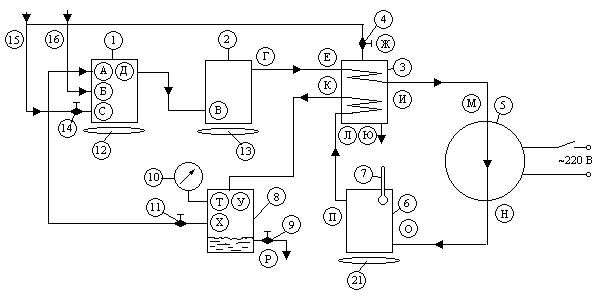
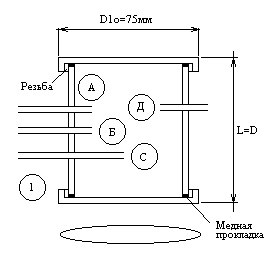
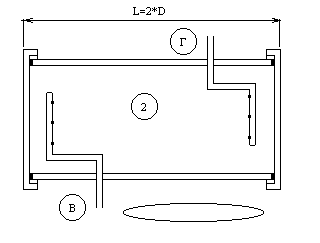
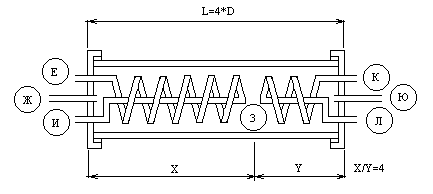
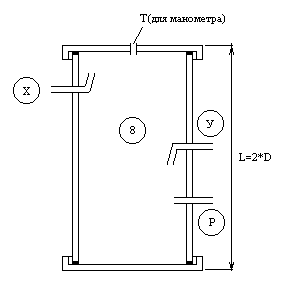
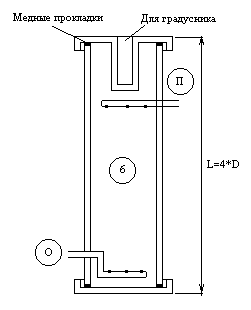
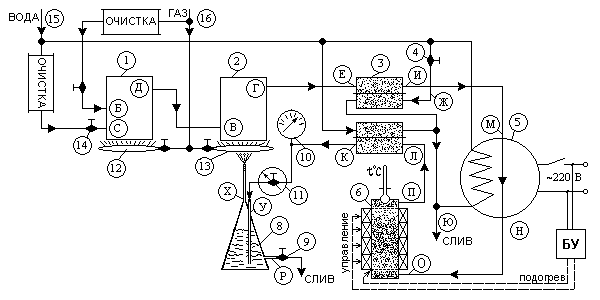
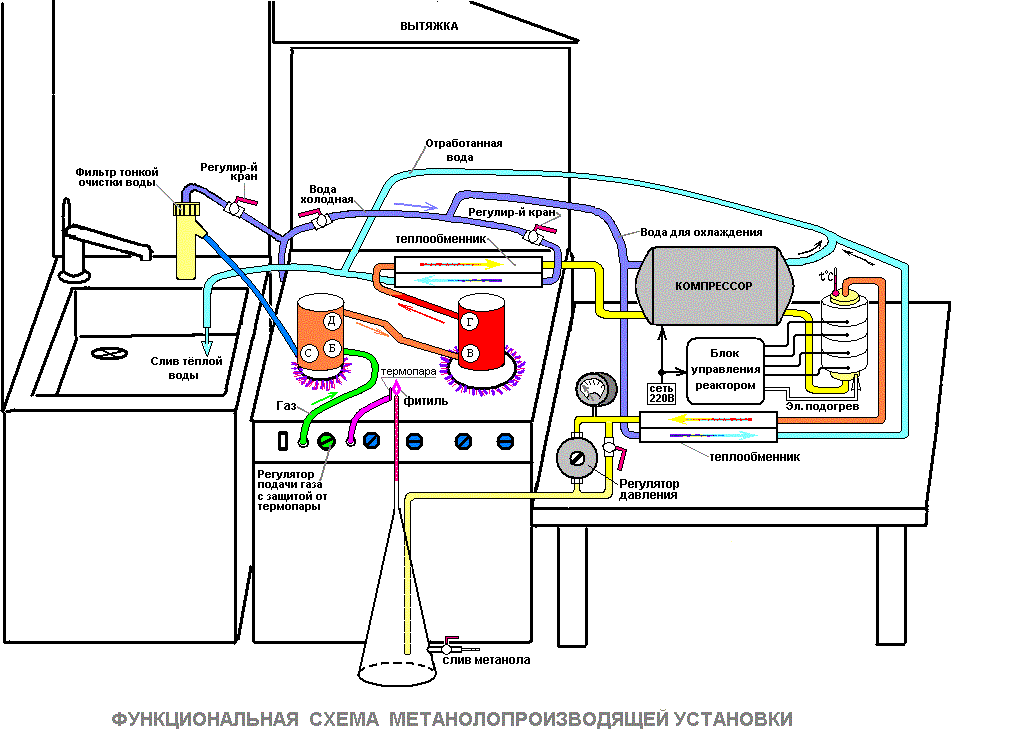

Comments
When commenting on, remember that the content and tone of your message can hurt the feelings of real people, show respect and tolerance to your interlocutors even if you do not share their opinion, your behavior in the conditions of freedom of expression and anonymity provided by the Internet, changes Not only virtual, but also the real world. All comments are hidden from the index, spam is controlled.